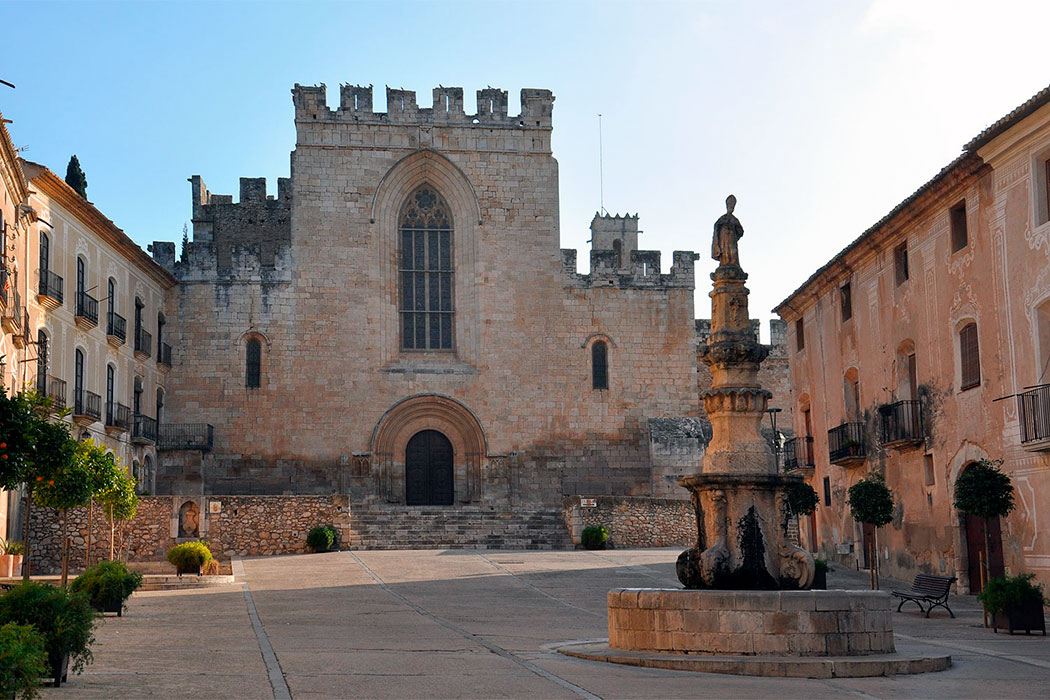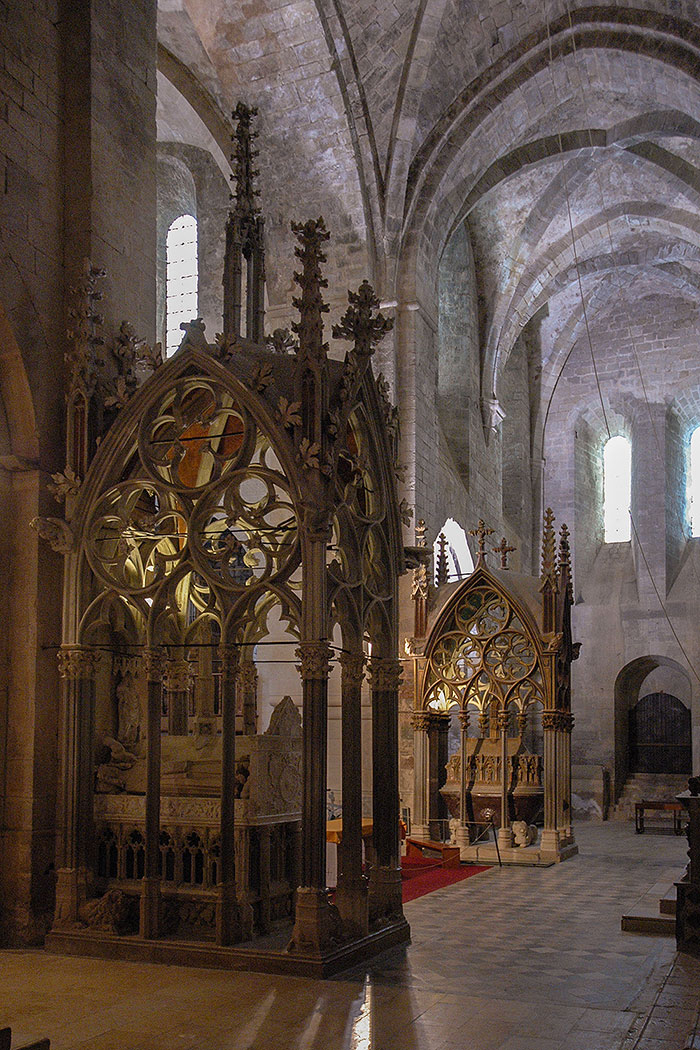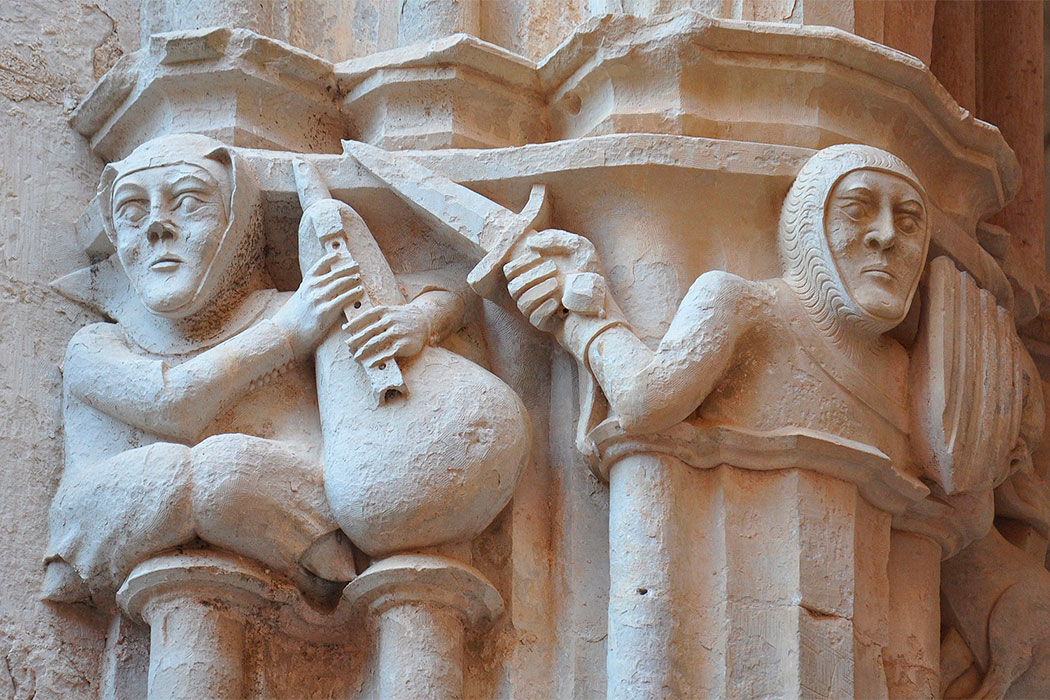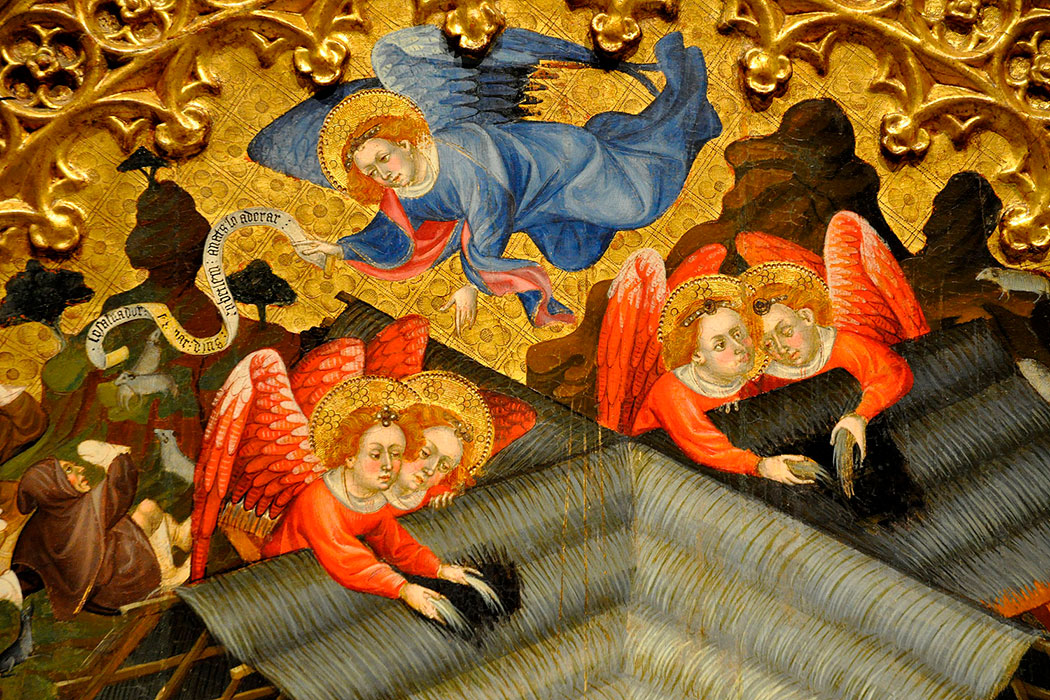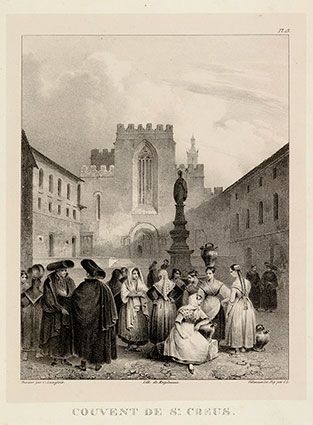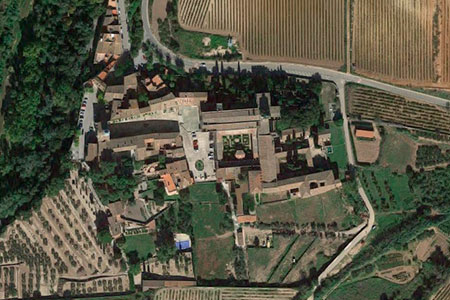Monastery of Santes Creus
Santa Maria de Santes Creus / Sanctae Cruces / Sanctis Crucibus
(Aiguamúrcia, Alt Camp)
It is one of the great monasteries of Catalonia, due to its history, architectural value, and good state of conservation. The construction of this monastic residence in Alt Camp was preceded by a temporary establishment on the northern slopes of the Collserola mountain range after the seneschal of Barcelona Guillem Ramon I de Montcada donated some land in Valldaura (Vallès Occidental) to the Cistercians of the Occitan Grandselve Abbey (Tarn-et-Garonne) in 1150.
The site of Valldaura was not suitable for a Cistercian monastic establishment, so in 1155 the Count of Barcelona Ramon Berenguer IV intervened and gave a property of his own in Ancosa (la Llacuna, Anoia) with better geographical conditions for the monastery. It is believed that the monks never settled there, as it was not entirely suitable. In 1160 a new donation was made with the land of Santes Creus, near the Gaià, with a pre-existing church considered to be of eremitic origin, where the monastery was finally erected. The foundation was not fully completed until 1168, when a papal bull by Alexander III declared the new residence to be directly dependent on Rome, free from episcopal intervention. After the first few abbots of Occitan origin, Pere de Valldaura (1158-1184), the first abbot born in the country, was appointed to this post.
Around 1170, provisional constructions began to accommodate the monks who gathered around the chapel of the Santíssima Trinitat, which is still preserved today. At the same time, the neighbouring community of Sant Pere de Gaià was added. Later (1174) the construction of the definitive monastery began, following the distribution of the spaces characteristic of Cistercian monasteries. In 1221, the church was consecrated, although it is possible that it was not yet finished. A cloister was also built before the present one, of which the temple of the basin is still preserved, with a simpler decoration, which contrasts with the rest, built later.
The sacristy, chapter house and the parlour (which connects the cloister with the rear part of the complex) belong to this early period. The monks' dormitory, begun in 1191 and completed in the 13th century, was built on top of this complex shortly afterwards. Under the abbotship of Saint Bernat Calbó (1226-1233) and after a period of economic problems, construction activity was resumed, thanks to the collaboration of the sovereigns.
Peter III of Aragon (1240-1285) was the first monarch to be buried in the monastery. Later, the transept of the church housed the tomb of his son James II the Just (1267-1327) and his wife Blanche of Anjou (1283-1310). It was at this time that the Royal Palace was built. Abbot Bonanat of Vila-seca founded the branch monasteries of Valldigna in La Safor (1298) and Altofonte, near Palermo, Sicily (1308). Santes Creus was also involved in the foundation of the military order of Montesa in 1319.
In 1313 the foundation stone was laid for a new cloister, which was to replace the previous one, which had not yet been completed. This cloister departs from the characteristic Cistercian style and is exuberantly decorated with figures of all kinds, but with a predominance of fabulous figures, with monstrous animals, to the detriment of religious scenes. Reinard Fonoll, probably an Englishman who was hired in 1332 by the abbot Francesc Miró (1335-1347), worked on this project. This cloister was inaugurated in 1341 and restored in the 20th century.
A long period of decadence followed, which did not prevent further minor works from being carried out, such as alterations to the Royal Palace and the adaptation of the armarium as the Chapel of the Assumption in the cloister. Between 1376-77, defensive structures were added, with the battlements crowning the church and the cloister. In 1452 the assets of Santa Maria de Bonrepòs passed to Escaladei and Santes Creus, the former keeping the nearby properties and the latter the liturgical objects and the more distant properties. It has been said that the rear cloister of Santes Creus comes from Bonrepòs.
The final years were of relative prosperity, and several works were carried out to adapt the monastery buildings. A new abbot's palace was built in 1640 on the site of the former Hospital of the Poor, the infirmary was built in 1733 and the refectory, which lost its Gothic features, was enlarged. In the second half of the 18th century, the development of the squares and the construction of the Assumption Gate were completed.
In the 19th century, the monastery experienced the misfortunes of the period. As for the War of Independence, although the troops entered and the community fled temporarily, it seems that neither the buildings nor the furnishings were particularly damaged. In 1820 it was suppressed, and its assets were put up for auction, the whole being divided into different lots, although the losses of the furnishings were limited. The community was reintegrated in 1823 but the monastery was definitively abandoned in 1835, as a consequence of the events of July in Reus and Barcelona, at which time and despite the situation, the community still had thirty-five members.
In 1843 the former monk Miquel Mestre, rector of the parish, founded the village of Santes Creus; he asked for the main church for the parish, and returned it to worship. Later, the Abbot's palace became the seat of the town council. The transfer of the Tarragona prison (1870) and the third Carlist War (1874) caused significant destruction, which was later repaired by the Tarragona Monuments Commission. In 1921 it was declared a national monument and from then on important restoration and conservation work was carried out. This important monument is now the property of the Generalitat de Catalunya.
Affiliation of Santes Creus
According to Originum Cisterciensium (L. Janauschek, 1877)Grandselve Abbey (Tarn-et-Garonne) / 1145
Monastery of Santes Creus (Alt Camp) / 1152
Monastery of Valldigna (Valencia) / 1279
Abbey of Altofonte (Sicily) / 1307
Tomb of Peter III of Aragon, the Great
The tomb of Peter III of Aragon (1240-1285) was commissioned by his son James II, who had it built in the place chosen by his father (i.e. this monastery of Santes Creus) even though he had been excommunicated. In 1291, the master builder Bartomeu de Girona was commissioned to make it using a Roman-Egyptian bath sent by James II himself when he was King of Sicily. The tomb is made up of the old tub, a shrine decorated with images above it and the whole thing covered by a baldachin. The royal body was transferred to this burial place in 1295, then the canopy and the gilding were made and finished ten years later. This tomb was opened in 2010, at which time the remains of the monarch were investigated, and the ensemble was restored and cleaned.
Tomb of James II and Blanche of Anjou
Tomb of Jaume II (died 1327) and Blanca of Anjou (†1310). The work was carried out between 1311 and 1316, and several masters were involved (Pere de Prenafeta, Pere de Bonull and Francesc de Monflorit). It was modelled on the tomb of Peter the Great.
Altarpiece of the Virgin
In 1403 a new altarpiece was commissioned, a work begun by Pere Serra, who must have made the preparations and finished in 1410 by Lluís Borrassà, who also worked on it with Guerau Gener. The altarpiece consisted of two sections separated by the image of the Virgin. On each side there were four large scenes depicting the life of the Virgin, as well as the pinnacles with the Evangelists and the poorly preserved predella. The altarpiece is now conserved in the MNAC (Barcelona) and the Museu Diocesà de Tarragona.
- Album pintoresch-monumental de Catalunya - Santes Creus (1883). Barcelona: A. C. d'Excursions Científicas
- BALUJA, Josep; OLIVER, Jesús M. (2008). Els capitells del claustre de Santes Creus. Valls: Cossetània
- BALDOR ABRIL, Elisabeth (1999). El monestir de Santes Creus des del primer abadiat quadriennal a la guerra dels Segadors (1619-1641). Valls: C. C. Alt Camp
- BARRACHINA NAVARRO, Jaume (2007). El mestre Bartomeu de Girona. L'art gòtic a Catalunya. Escultura I. Barcelona: Enciclopedia Catalana
- BARRAQUER I ROVIRALTA, Gaietà (1906). Las casas de religiosos en Cataluña durante el primer tercio del siglo XIX. Vol. 1. Barcelona: J. Altés
- BARRAQUER I ROVIRALTA, Gaietà (1915-16). Los religiosos en Cataluña durante la primera mitad del siglo XIX. Tomo I / III. Barcelona: J. Altés
- CABESTANY I FORT, Joan-F. (1995). Santa Maria de Santes Creus. Catalunya romànica. Vol. XXI. Barcelona: Enciclopedia Catalana
- CABESTANY I FORT, Joan-F. (2003). El monestir de Santes Creus. L'art gòtic a Catalunya. Arquitectura II. Barcelona: Enciclopedia Catalana
- CARRERAS I CASANOVAS, Antoni (1992). El monestir de Santes Creus 1150-1200. 2 vol. Valls: I. E. Vallencs
- CARRERO SANTAMARÍA, Eduardo (2018). El claustre posterior del monestir de Santes Creus. Una perspectiva des del Cister de la Corona d’Aragó. Santes Creus: Revista de l’Arxiu Bibliogràfic
- DOMÍNGUEZ BORDONA, J. (1952). El escritorio y la primitiva biblioteca de Santes Creus. Tarragona. I. E. Tarraconenses
- CREUS, Teodoro (1884). Santas-Creus. Descripción artística de este famoso monasterio. Vilanova i al Geltrú: F. Miquel
- ESPAÑOL, Francesca (2003). Els palaus abacials i les residències reials als monestirs. L'art gòtic a Catalunya. Arquitectura III. Barcelona: Enciclopedia Catalana
- FORT I COGUL, Eufemià (1964). La canónica de Barcelona y el monasterio de De Valldaura-Santes Creus. Yermo. Vol. 2, múm. 1. Santa María de El Paular
- FORT I COGUL, Eufemià (1964). El primer abad de Valldaura-Santes Creus y comentario a la cronología de los principios del monasterio. Yermo. Vol. 2, múm. 3. Santa María de El Paular
- FORT I COGUL, Eufemià (1967). Llibre de Santes Creus. Barcelona: Selecta
- FORT I COGUL, Eufemià (1972). El Senyoriu de Santes Creus. Barcelona: F. Vives Casajuana
- FORT I COGUL, Eufemià (1972). Santes Creus de l'exclaustració ençà. Santes Creus
- FORT I COGUL, Eufemià (1976). El monestir de Santes Creus. Vuit segles d'història i d'exemplaritat. Santes Creus
- FORT I COGUL, Eufemià (1978). Sant Bernat Calbó abat de Santes Creus i bisbe de Vic. Reus: Ass. Estudis Reusencs
- GUITERT, Joaquín (1927). Real Monasterio de Santes Creus. Barcelona: Casa de Caritat
- HERNÁNDEZ SANAHUJA, Buenaventura (1886). Historia del Real Monasterio de SS. Creus: su fundación, progresos... Tarragona: V. H. Tort
- JANAUSCHEK, Leopoldus (1877). Originum Cisterciensium. Vol. 1. Viena
- LIAÑO MARTÍNEZ, Emma (2007). La primera escultura trescentista al monestir de Santes Creus. L'art gòtic a Catalunya. Escultura I. Barcelona: Enciclopedia Catalana
- MALLART RAVENTÓS, Lurdes (1990). Empremtes iconogràfiques angleses en els monstres del claustre de Santes Creus. Quaderns d'Història Tarraconense. Diputació de Tarragona
- MARTINELL, Cèsar (1929). El monestir de Santes Creus. Barcelona: Ed. Barcino
- MATA DE LA CRUZ, Sofia (2003). Una taula amb la Mare de Déu del Roser, procedent del monestir de Santes Creus. Taüll. Núm. 9
- MIQUEL, Marina; i altres (2012). Les tombes reials de Santes Creus. Tribuna d'Arqueologia (2010-2011). Barcelona. Generalitat de Catalunya
- OLIVER, Jesús M.; i altres (2008). Cister, monestirs reials a la Catalunya Nova. Valls: Cossetània
- PALOL SALELLAS, Pere (1957). El pie de altar, de época visigoda, de Santes Creus. Boletín Arqueológico. Núm. 57-60
- PONS TRAVAL, Juan Bta. (1896). Monasterio de Santas Creus (Tarragona). Barcelona: As. Arquitectos de Cataluña
- PAPELL I TARDIU, Joan (2005). Diplomatari del monestir de Santa Maria de Santes Creus (975-1225). Barcelona: Fundació Noguera
- RUIZ I QUESADA, Francesc (2005). Guerau Gener. L'art gòtic a Catalunya. Pintura II. Barcelona: Enciclopedia Catalana
- SALAS, Ramón (1894). Monasterio de Santas Creus. Tarragona: Arís
- UDINA MARTORELL, Federico (1947). El “Llibre Blanch” de Santas Creus. Barcelona: C. S. I. C.
- VIVES I MIRET, Josep (1955). El enigma del claustro posterior de Santes Creus. Boletín del Archivo Bibliográfico de Santes Creus. Núm. 2. Santes Creus
- VIVES I MIRET, Josep (1969). Reinard des Fonoll escultor i arquitecte anglès renovador de l'art gòtic a Catalunya (1321-1362). Barcelona: Blume
